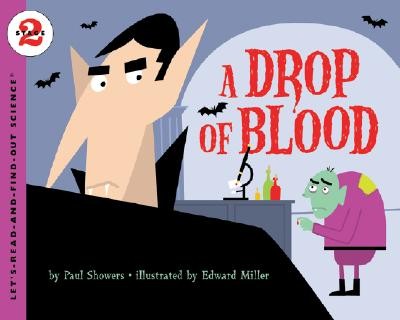| A Drop of Blood Contributor(s): Showers, Paul (Author), Miller, Edward (Illustrator) |
|
 |
ISBN: 006009110X ISBN-13: 9780060091101 Publisher: HarperCollins OUR PRICE: $5.39 Product Type: Paperback - Other Formats Published: May 2004 Annotation: You've seen your own blood, when you have a cut or a scrape. You can see the veins in your wrist, and you've seen the scab that forms as a cut heals. But do you know what blood does for you? Without blood, you couldn't play, or grow, or learn. That's because just about every part of your body needs blood, from your muscles to your bones to your brain. How does your body use blood? Read and find out! Ages 10 - 14 |
| Additional Information |
| BISAC Categories: - Juvenile Nonfiction | Science & Nature - Anatomy & Physiology - Juvenile Nonfiction | Readers - Beginner - Juvenile Nonfiction | Science & Nature - Biology |
| Dewey: 612.11 |
| LCCN: 2004557612 |
| Lexile Measure: 480 |
| Series: Let's-Read-And-Find-Out Science 2 |
| Physical Information: 0.15" H x 10" W x 7.66" (0.30 lbs) 32 pages |
| Accelerated Reader Info |
| Quiz #: 13806 Reading Level: 3.6 Interest Level: Lower Grades Point Value: 0.5 |
| Descriptions, Reviews, Etc. |
| Publisher Description: Read and find out about how your body uses blood in this colorfully illustrated nonfiction picture book. You've seen your own blood, when you have a cut or a scrape. You can see the veins in your wrist, and you've seen the scab that forms as a cut heals. But do you know what blood does for you? An excellent choice for units on the circulatory system or to take the fear out of cuts, scrapes, and blood tests, according to a School Library Journal starred review. Without blood, you couldn't play, or grow, or learn. That's because just about every part of your body needs blood, from your muscles to your bones to your brain. How does your body use blood? Read and find out! This is a clear and appealing science book for early elementary age kids, both at home and in the classroom. It's a Level 2 Let's-Read-and-Find-Out, which means the book explores more challenging concepts for children in the primary grades. The 100+ titles in this leading nonfiction series are:
Top 10 reasons to love LRFOs:
Books in this series support the Common Core Learning Standards, Next Generation Science Standards, and the Science, Technology, Engineering, and Math (STEM) standards. Let's-Read-and-Find-Out is the winner of the American Association for the Advancement of Science/Subaru Science Books & Films Prize for Outstanding Science Series. |
Contributor Bio(s): Miller, Edward: - Edward Miller has illustrated A Drop of Blood and What Happens to a Hamburger? for the Let's-Read-and-Find-Out Science series. He lives in New York City. Showers, Paul: - Paul Showers wrote twenty books for the Let's-Read-and-Find-Out Science series, including favorites such as What Happens to a Hamburger? and Where Does the Garbage Go? Mr. Showers worked on the Detroit Free Press, the New York Herald Tribune, and for thirty years, the Sunday New York Times. |